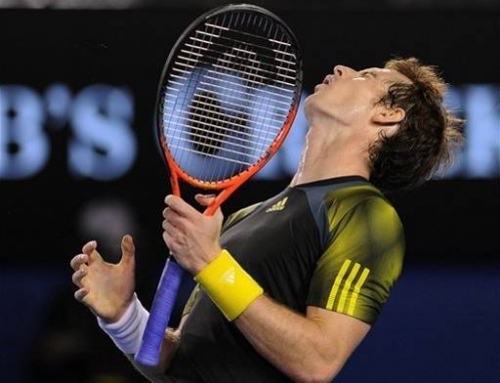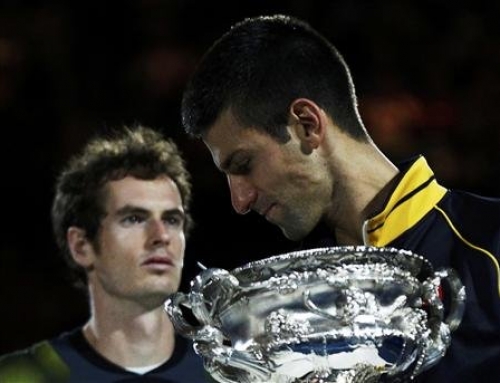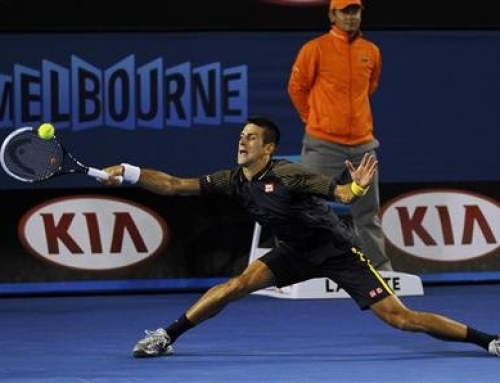 And that’s why no one plays serve and volley anymore.
And that’s why no one plays serve and volley anymore.
Michael Llodra is perhaps the last of a dying breed. The serve-and-volleyer. It isn’t a coincidence that Llodra is just north of 30 years old. I know, I know, veterans will tell you that everyone’s forgotten how to volley. You have to be around 30 to remember what it was like to volley on a consistent basis. Ivo Karlovic, he of the huge serve and forehand, actually volleys pretty well. He has to. His movement on the baseline is a liability, so he better know his way around the net. You can see he has the skills of someone who volleys a fair bit.
But a serve-and-volleyer takes so many risks. To be successful as a serve-and-volleyer you need to, first and foremost, have a good enough first serve to win a few free points with no returns. People forget that. They seem to think that everytime a serve-and-volleyer served, they volleyed.
Well, they didn’t. They relied on a few missed returns each game. Without it, the returner gets too many good looks at passing each game. And that’s really the reason that serve and volley died. Returners began returning 10 feet behind the baseline. During the days of Laver and Rosewall, such an idea would be pure folly.
Several reasons, according to the old mindset. First, you give up a lot of court. The volleyer has that much more time to get to net. Second, and this was something the net rushers of the day never considered, you have to hit much harder that far back to make a pass. The players of the day never imagined that people would hit hard whipping topspin shots that were much harder and, more importantly, much more accurate than the returners of their day that either blunted the ball back or chipped it. They didn’t imagine people taking good hard swipes and having it dip down.
Topspin also meant that passers could dip the ball sharply into the service boxes. In the old days, passing shots often landed close to the baseline. With a flat pass, you can’t dip the ball so violently. Sure, the strings have a lot to do with that now, but when you can reliably dip the ball, and hit it inside the sidelines time and time and time again, any advantage a serve and volleyer has is negated.
And clearly, Llodra is good enough to play the modern game. He may not be able to routinely beat Murray or Federer or Nadal or Djokovic, but his hard hitting, hard charging style creates problems for lower ranked players who aren’t used to making passing shots. One result of the demise of serve and volley is struggling to hit pass after pass after pass. Your mind has to be sharp to do that.
Murray has always said he liked a target, and so he does. This match turned out to be a lot of fun with Llodra having to use drop volleys of all sorts to get to Murray, and Murray using his touch to counter Llodra. There were lobs, drop shots, drop shots off drop shots, tweeners. It makes you sad that there aren’t more serve and volleyers, even if their chances of winning aren’t so great. Murray’s contorted look in the picture was a set point where Llodra hit a tweener right into Murray’s body and Murray barely moved out of the way, hit the volley, before falling backwards.
But with Murray getting back so many serves, Llodra was pressured time and again to deal with passing shots. And in the end, the barrage of shots was too much for the wily Frenchman.
Final score: 64 62 60
Murray’s draw had set up the possibility of meeting the French Davis Cup team in successive rounds. He had already played Roger-Vasselin, admittedly, not ranked high enough to be on the team, then Llodra. He could have met Monfils then Tsonga. But Monfils didn’t make it past the Kazakh player, Mikhail Kukushkin. Now, as it turns out, Kazakhstan doesn’t exactly have its own players. Kukushkin is Russian. What it does have is money, so they’ve cobbled a team of players that were considered not quite ready for Russian prime time to play for the Kazakhstanis.
Anyway, Monfils apparently had some issues with injuries of some sort. Not bad enough that he had to default, though apparently he was extensively seeing trainers, and not good enough that he could handle Kukushkin easily. Kukushkin took the first two sets 62, 75 and an upset was brewing. But Monfils managed to come back and take the next two sets 75, 61 with Kukushkin’s game seemingly falling apart. Monfils even had a break in the fifth set, but Kukushkin broke to tie it. Then in a critical game where Monfils was serving, someone tossed a tennis ball onto the court. In a point that Monfils appeared to be winning, Monfils eventually lost serve and Kukushkin took the fifth set, 64.
As it turns out, Kukushkin’s next opponent is Andy Murray. The two have only played once, but that was two weeks ago in Brisbane as Murray was struggling to find ways out of his first two rounds. Murray said he almost lost to Kukushkin, but finally got his game in gear. Murray will probably be happy to see Kukushkin instead of Monfils (although Murray has an excellent record against the French) and happier still that Kukushkin won in 5 long sets and looked somewhat shaky in victory. Murray is staring to look sharp, but playing a serve and volleyer can do that.
Kei Nishikori appears to be a slow starter. He was asked about this back in Shanghai. He said he prefers to win in straight sets, but was finding himself fighting to win matches in three sets. Nishikori needed five sets (down two sets to love) to beat local Aussie Matthew Ebden, and found himself a set down against Julien Benneteau, who was a finalist in Sydney just this past week. Nishikori won two tiebreaks in a row, and had to get breaks in the third set just to do that. However, he did take the match in four sets.
Up next for Nishikori is Jo-Wilfried Tsonga who has been cruising the past few rounds, admittedly against rather weak opponents. Tsonga crushed Portugal’s Frederico Gil 62 62 62.
Djokovic also had an easy match against Nicolas Mahut, though word was, Mahut was injured but didn’t want to retire. The match was 60 61 61. Up next for Djokkoic is Lleyton Hewitt. Hewitt had to face the big serving Canadian, Milos Raonic. Goes to show that Raonic’s game is still rough around the edges and that Hewitt’s never-say-die attitude is good enough for him to win matches. Hewitt should win a few games off Djokovic, but it’s hard to see him winning. Still, Hewitt’s been playing better than usual. Maybe he can win a set.
David Ferrer found himself down double-break against Juan Ignacio Chela. But then Ferrer turned it on. Chela is a rugged baseliner that gets lots of shots back. But Ferrer just does this better. Ferrer may be known for pressuring players bigger than him, but he’s also got the steadiness to beat players like Chela who grind it out. Ferrer is often thought of as a counter-puncher, but he’s an aggressive counter-puncher. He’s no Gilles Simon who pushes the ball around waiting for the error. Ferrer is a pretty aggressive ball striker. He’s not going for winners, but he is trying to maneuver the game to his liking. Even when you pressure him, he is able to get solid shots back. Chela finally wilted under the withering blows of the feisty Spaniard losing 75 62 61.
Richard Gasquet has been playing pretty well as of late and beat top ten player Janko Tipsarevic handily, 63 63 61. Up next for the Frenchman is David Ferrer. Gasquet doesn’t like playing Ferrer. He’s on the “one” side of a 5-1 head to head and the wins that Ferrer has had have been lopsided. Gasquet is a flashy player but he needs steadiness. Still, Tipsarevic is somewhat like Ferrer in playing style, so perhaps Gasquet can keep it interesting.
Tomorrow, Federer takes on Tomic.






![[Aussie Open Final] Can Andy Murray beat Novak Djokovic?](https://www.essentialtennis.com/wp-content/uploads/2013/01/20130126andy-500x383.jpg)
![[Day 13, Aussie Open] Bryan brothers win 13th Slam with Aussie doubles title, Kyrgios wins boys title](https://www.essentialtennis.com/wp-content/uploads/2013/01/20130125bryan-500x383.jpg)